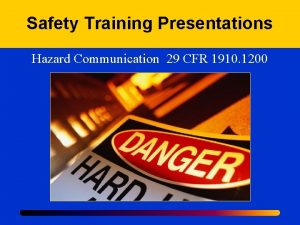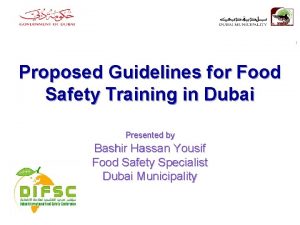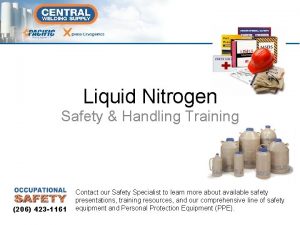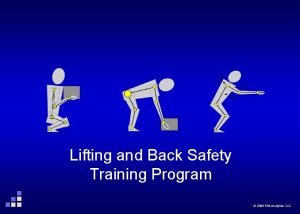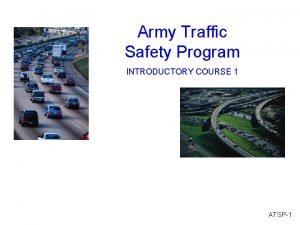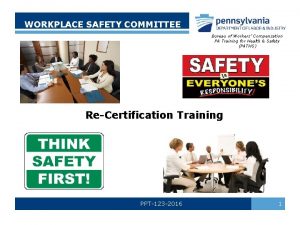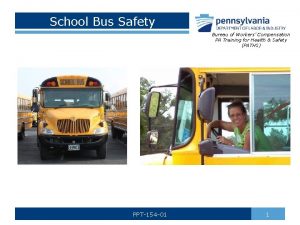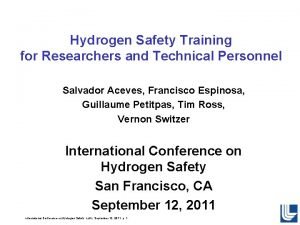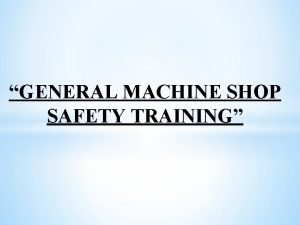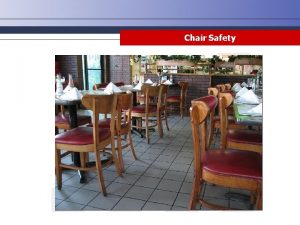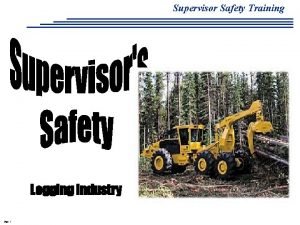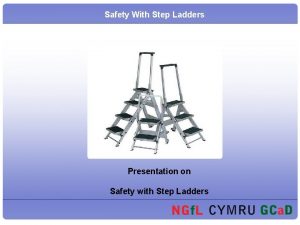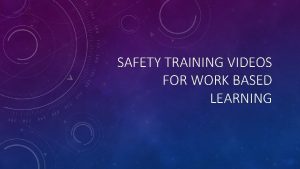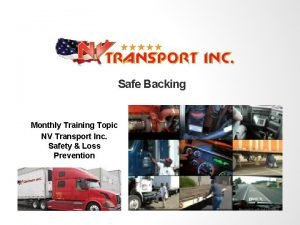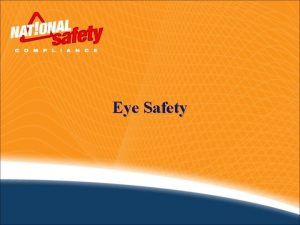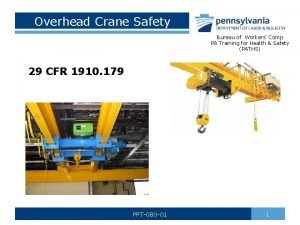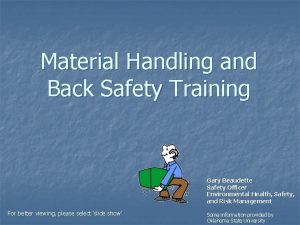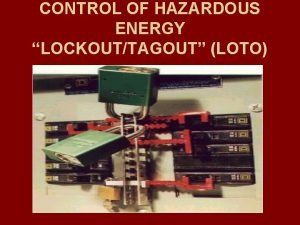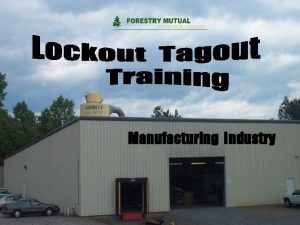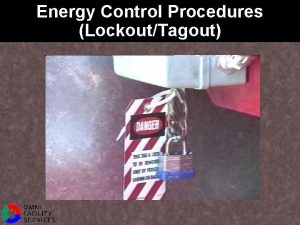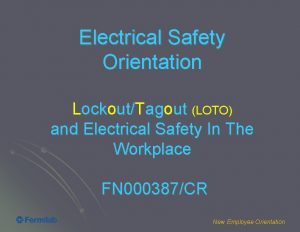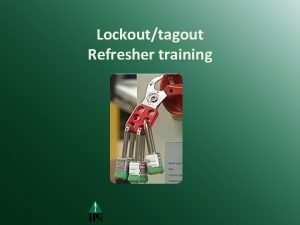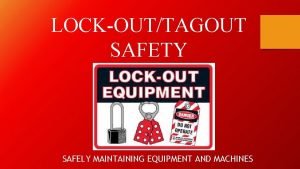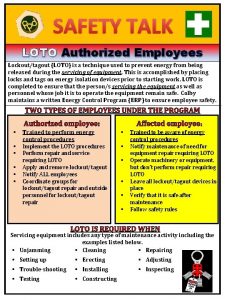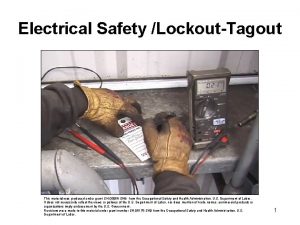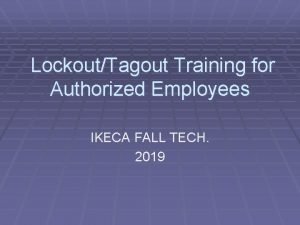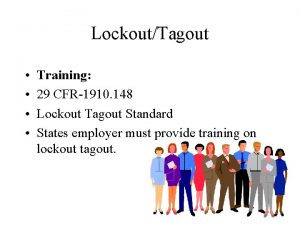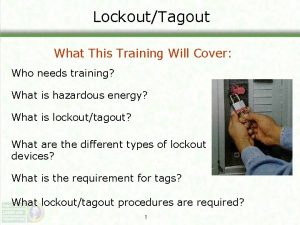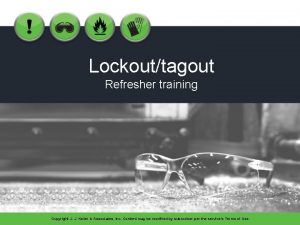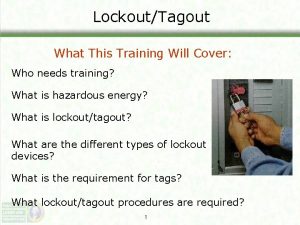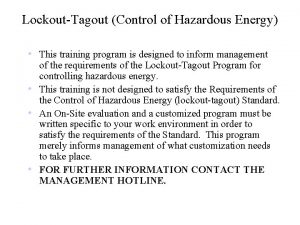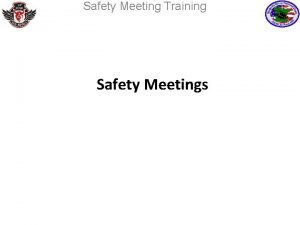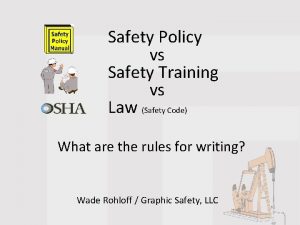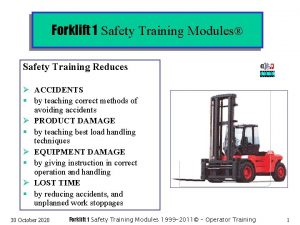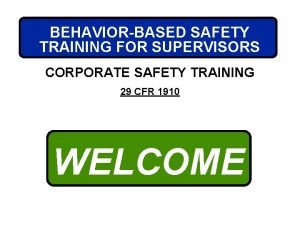LockoutTagout Safety Training LockoutTagout What This Training Will


































- Slides: 34

Lockout/Tagout Safety Training

Lockout/Tagout What This Training Will Cover: Who needs training? What is hazardous energy? What is lockout/tagout? What are the different types of lockout devices? What is the requirement for tags? What lockout/tagout procedures are required? 1

Who Needs Training? Authorized employees –people who lock or tag out machines or equipment to perform servicing. Affected employees –people who use machines or equipment on which servicing is performed under lockout/tagout. Other employees –people who work in the area of locked out machinery or equipment 2

What is Hazardous Energy? Hazardous energy is one of the following: Electricity – live or stored Moving machinery parts Stored mechanical movement in machinery 3

What is Hazardous Energy? Stored heat (steam lines or hot liquids) Chemicals in pipelines under pressure or force of gravity Any other active or stored energy sources that could harm a worker 4

Hazardous Energy Source Examples Live electrical lines Electrical capacitors Lasers Engines that move machinery parts Hydraulic lifts Pneumatic (air pressure) lines Springs 5

Lockout/Tagout and Confined Spaces Lockout/Tagout is important in confined spaces since it is easy to get trapped and hard to escape. Pipelines leading into tanks must be blanked off before entering the space. All electrical and mechanical hazardous energy must be addressed and locked out or tagged as needed. 6

Our Hazardous Energy Sources We have evaluated this workplace and found the following hazardous energy sources requiring lockout/tag-out procedures: List specific workplace hazardous energy sources here 7

What kind of injuries can happen? Electrocution from live parts Scalding from steam or hot liquids Chemical burns or poisoning From machinery: - Deep cuts and gashes - Crushing injuries - Amputations All of these can be fatal when severe 8

Fatality Example A man working inside a supermarket cardboard compactor was crushed when the unblocked compactor suddenly came down on top of him. Link to other fatality examples 9

When is Lockout/Tag-out required? When someone will be servicing or repairing machinery or equipment AND the unexpected machinery startup or release of stored energy could cause injury 10

Service and Maintenance Examples Installing, constructing, adjusting, modifying, unjamming, cleaning, lubrication, inspecting, setup - preparing for normal function These activities often require a worker to place all or part of their body into the machine’s hazard zone. 11

What is an energy-isolating device? A device that physically prevents transmission or release of energy such as: An electrical circuit breaker, A pipeline valve, A machine block, Anything else that positively blocks or isolates energy. 12

What is a Lockout Device? A device that positively: prevents a machine from being started up or turned on, prevents a machinery part from moving, prevents electrical energizing, blocks a pipeline, steam line or air line 13

Electrical Lockout Devices Locked out circuit breaker Locked out electrical panel Locked out electrical plug 14

Fluid & Gas Lockout Devices 15

Pipe Lockout Examples 16

Pneumatic Lockout Examples 17

Physical Blocks Punch press blocks Truck bed lockout 18

Group Lockout Devices Used when more than one person doing maintenance or repair on same machine or equipment. Machinery or equipment can’t be started up until all locks are removed. Each person places and removes their own lock. 19

Example of a bad lockout/tagout 20

Lockout Devices We Use Describe or show your lockout devices here and why they are used. 21

What is Tag-out? Tags are warning devices only They don’t provide the same level of protection as lockout devices. They can only be removed by an authorized person. They must be legible, securely attached and resistant to degradation. 22

Energy Control Program Describe or discuss your company’s energy control program here. Include specific procedures for each machine. 23

Lockout Procedures Six Steps to Follow: 1. Notify affected employees that machine or equipment will be shut down and locked out 2. Shut down the machinery or equipment 3. Isolate energy sources with energy-isolating devices 24

Lockout Procedures Six Steps 4. Lock out energy-isolating devices with assigned locks. 5. Release or restrain stored or residual energy 6. Test machinery to make sure it can’t start up 25

Lockout Steps Notify employees Shutdown Equipment Isolate Energy Attach Lockout Device Release Stored Energy Verify Lockout Service & Maintenance 26

Examples of Release of Stored Energy � “Slowly open the receiver tank port and bleed off any internal pressure. ” � “Loosen both line valves to relieve all pressure in the cooling circuit. ” � “Ground out capacitor…” 27

Examples of Attempt to Operate � “…adjust the temperature cycle thermostat to check that all electrical energies have been shut off. ” � “Push the start function button to verify that electric power has been removed. ” � “Crack the steam inlet and discharge line outlet valves…” 28

Start-up Procedures Only authorized employee can do startup All warned to stay clear Remove all tools, locks and tags Remove, reverse, open or reactivate isolating devices Visual check that all is clear Start up machine, process or line flow 29

Quiz Question 1 Which of the following is not hazardous energy? a) Electricity b) Compressed air c) Steam d) Cold water in a pipe 30

Quiz Question 2 When are warning tags alone O. K? a) Always b) Never c) When everyone knows what they mean d) When there is no alternative 31

Quiz Question 3 When can you not follow lockout procedures? a) When the foreman says so b) Never c) If you know where everyone is d) When needed to meet a deadline 32

References � Information provided by OSHA Compliance Suite- Boyer Safety Services 1 -800 -664 -8401
 Safety care certification
Safety care certification What is catzoc
What is catzoc Process safety vs personal safety
Process safety vs personal safety Safety assessment for ind safety reporting
Safety assessment for ind safety reporting Basic safety orientation
Basic safety orientation Construction site safety orientation
Construction site safety orientation 29 cfr 1910 osha 178
29 cfr 1910 osha 178 Food hygiene training in dubai
Food hygiene training in dubai Liquid nitrogen training
Liquid nitrogen training Safety awareness topics
Safety awareness topics Fuel tank safety training ppt
Fuel tank safety training ppt Osha fire extinguisher training powerpoint
Osha fire extinguisher training powerpoint Army traffic safety program
Army traffic safety program 15-passenger van training exam answers
15-passenger van training exam answers Pa safety committee training
Pa safety committee training Nuclear safety training
Nuclear safety training Ladders and stairways
Ladders and stairways Flagman safety training ppt
Flagman safety training ppt Hydrogen safety training
Hydrogen safety training Pinch point safety definition
Pinch point safety definition Food safety training abu dhabi
Food safety training abu dhabi Dilbert chair safety training
Dilbert chair safety training Boiler training ppt
Boiler training ppt Power tool safety powerpoint presentation
Power tool safety powerpoint presentation Safety images
Safety images Ladder safety powerpoint
Ladder safety powerpoint Osha training videos
Osha training videos Leader safety course module 2 answers
Leader safety course module 2 answers Safe backing techniques
Safe backing techniques Eye safety training
Eye safety training Safety training objectives
Safety training objectives Behavior based safety training ppt
Behavior based safety training ppt Overhead crane training ppt
Overhead crane training ppt Gary beaudette
Gary beaudette Keolis safety training
Keolis safety training






